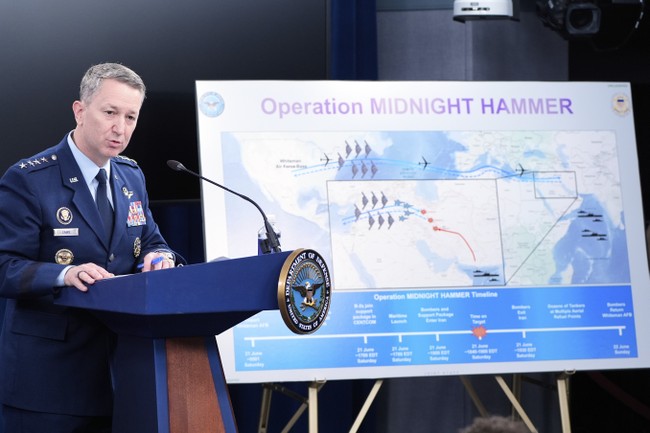
“Operation Midnight Hammer was the culmination of those 15 years of incredible work,” General Dan ‘Razin’ Caine told reporters this morning in a briefing on the strikes in Iran. The Pentagon developed the GBU-57 bunker-buster in part for this mission, modeled its effects ‘extensively,’ and applied it directly on target. Gen. Cain made sure everyone knew that this was not an impulsive idea, but rather the fruition of a long-game strategy matched with the specter of acute weaponization — and the will to defeat it.
The story begins when Western intelligence first noticed the Iranians building something significant at Fordow, Cain explains:
Gen. Dan “Razin” Caine, Chairman of the Joint Chiefs, revealed that it took over 15 years of detailed planning and analysis to the successful destruction of Iran’s nuclear infrastructure. pic.twitter.com/KmSsCNwWGX
— Open Source Intel (@Osint613) June 26, 2025
Not only did the Pentagon develop the GBU-57 to penetrate and destroy Fordow, they also tested it. Caine apparently didn’t get into too many details there, but he did show super-slo-mo video of one such test. For those who scoffed at the lack of obvious damage at the surface in before-and-after satellite photos, Caine instructed that these munitions are not designed for that outcome. Instead, the subterranean blast and shockwaves are intended to destroy tunnels and equipment.
Dropping twelve of them on the two vent shafts means a massive amount of shockwaves and blast damage, Caine concludes, noting that all twelve went precisely where they were targeted:
WATCH 🔴
Gen. Dan “Razin” Caine presented and played a video demonstrating how the GBU-57 bunker busters operate.
“Unlike a normal surface bomb, you won’t see an impact crater because they’re designed to deeply bury and then function … All six weapons at each vent at Fordow… pic.twitter.com/C7et3D06GI
— Open Source Intel (@Osint613) June 26, 2025
Even if Fordow was just a weapons bunker, it would likely be next to useless after this attack. However, it wasn’t just another bunker; its operations required delicate stability for the centrifuge cascades to enrich the uranium. Even assuming the site is still accessible — and that’s assuming a lot, considering the amount of ordnance that dropped down those vents — the enrichment capacity is utterly wrecked. The IAEA knew that right off the bat, and that was the big threat from Fordow, and why the Iranians buried it as deeply as they did.
CNN’s analyst was convinced:
🚨TRUTH AIRED ON CNN, FINALLY — After spreading fake news: “It worked! It seems to have worked flawlessly!”
Total Trump vindication.
“I think from what I’ve seen, the 20,000 centrifuges…they are all completely destroyed. I am VERY CONFIDENT those centrifuges are GONE!”
In… pic.twitter.com/1ZIPhzzsMR
— Townhall.com (@townhallcom) June 26, 2025
However, there has been some goalpost-moving over the last few days:
JUST IN 🔴
Financial Times: European officials believe Iran moved uranium out of Fordow before U.S. strikes.
— Open Source Intel (@Osint613) June 26, 2025
Is that possible? Yes, but it seems pretty unlikely. In the first place, Fordow was built to be the safest facility in Iran for their uranium stores and final-stage enrichment. Where would they have taken the uranium to make it safer? The other facilities for enrichment activities — Natanz and Isfahan — were more exposed and also destroyed. Plus, the US and Israel have been watching Fordow closely for years, and especially closely over the last three months when the situation became acute in March. That kind of larger-scale move would have been spotted, and the destination of the uranium targeted as well by the IDF during the 12 Day War. Presumably, that would have been the first target after eliminating Iran’s air defenses.
Trump scoffed at the idea this morning:
Plus, that kind of move would have not been in character with the incompetent character of this regime. They assumed the US would get scared off by their threats and knew Israel couldn’t effectively target Fordow. Their theocratic-based strategy would not have allowed consideration of the possibility of this level of humiliation. The war revealed the Iranians to be inept even at home defense, so there’s no reason to think that they played 3-D chess with Fordow. Or to think that the Iranians built another redoubt of similar strength without being noticed.
We’ll see, of course, but I’d put this notion on the “sheer speculation” level of credibility until evidence emerges otherwise. And if it does, we’ll strike there, too.











